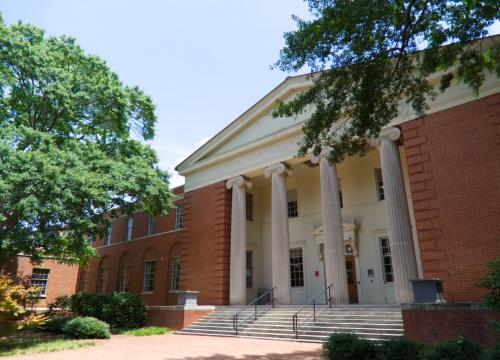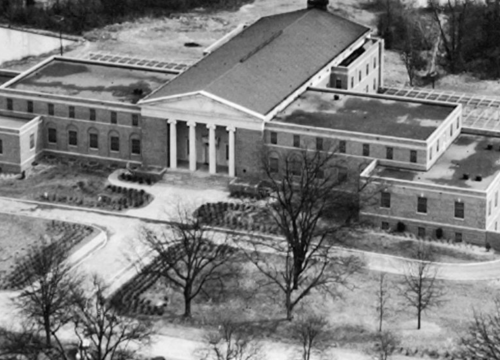Veterinary Medicine 1 – UGA 1070 (1949) (Category 2). The College of Veterinary Medicine is located at the southeastern corner of Brooks Drive and Carlton Street. The program was established in 1915 on South Campus and housed in Hardman Hall until 1932, when it was discontinued. The program was reestablished after World War II.
To accommodate a proposed new veterinary medicine building, the University drained a lake and regraded an associated campground facility. The new Veterinary School Building is shown on a 1947 plan of the campus. Completed in 1949, the building was expanded in 1973 through construction of an annex on the south side. Over the decades, the program has expanded and a number of additional facilities have been constructed to the west of the original building. A teaching hospital was constructed to the north of the original building in 1979.
The Veterinary School Building is a two-story brick structure that is H-shaped in plan. Its primary entrance faces Brooks Drive, with a gable portico of brick, stone, and stucco with Ionic columns and a recessed entrance. The gable roof of the entrance portico extends to the rear of the building. Front and rear brick wings extend to the north and south, crating the H-shape. The two story brick wings have limestone string courses and sills, double-hung windows, brick parapets, and flat roofs. The windows are modern aluminum replacements with insulating glass.
A number of additions and alterations have been made to the rear of the building to accommodate programmatic changes. The 1973 annex to the south is a simple two-and-one-half-story brick building set into the slope. It is connected to the original building with a corridor link at the second floor level. The annex has a flat concrete or stucco cornice band and is punctuated by windows in concrete frames. The large 1979 teaching hospital constructed on the east is of brick and concrete and is representative of the significant architectural vocabulary of 1970s.
Other buildings added to the complex are of varying character and significance. For the most part they are simple, utilitarian structures and tend to reflect the architectural character of their times.
Veterinary Medicine 1 retains integrity and appears to contribute to a National Register-eligible historic district. It is assessed as a Category 2 resource.


